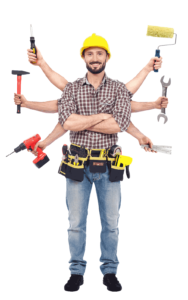Plumber Rockwall is a tradesperson who installs and repairs the water and waste systems that keep our homes and businesses functioning properly. This career requires extensive knowledge of building codes and blueprints to correctly lay out piping, connect fixtures and appliances, and troubleshoot issues like leaks.

Visually inspect accessible pipes for signs of leaks or rust, including water and drain lines. Run faucets and showerheads to test their operation and flush toilets to check for proper venting.
Plumbers install pipes and fixtures, such as sinks, toilets, bathtubs, showers, and water heaters. They also connect appliances like refrigerators and washing machines to these systems. They use specialized tools and skills to interpret blueprints and building codes when installing new plumbing systems. Plumbers often work with other professionals, such as construction workers and architects, to ensure that plumbing is integrated effectively into building projects.
Some plumbers specialize in specific types of plumbing systems. For example, some may only work on residential plumbing systems while others may focus on commercial or industrial systems. The type of plumbing system can influence the plumber’s daily responsibilities and workplace environment.
Plumbers can unclog toilets, repair garbage disposals, and inspect plumbing systems to identify potential issues. However, these are only a small fraction of the services they provide. In reality, plumbers do much more than that. They design piping systems that disperse water and remove waste in a safe and efficient manner. They also inspect and maintain these systems to reduce risks like leaks, flooding, and overflows. They even help ensure that sewage and potable water are separated so that contaminants do not enter the drinking supply.
As a result, plumbers must be comfortable working with electricity, chemicals, and other hazardous materials. They must also have excellent dexterity to work in tight spaces and around obstacles. The work can also be physically demanding since plumbers spend a lot of time on their feet, crouching, and lifting heavy objects.
Another important aspect of a plumber’s job is to make sure that all pipes are secure and sealed properly. This will protect against leaks and ensure that the water pressure is sufficient for each fixture. Additionally, the plumber should check for signs of corrosion or damage on all pipes and fixtures. This will help prevent future problems and costly repairs.
Plumbers often need to work outside of the office. They are often on call to respond to emergency situations, so they may need to work evenings and weekends. In addition, they must stay up-to-date on all new plumbing techniques and equipment to maintain their knowledge of the industry. Those who want to become plumbers should pursue a high school diploma or GED certificate and complete an apprenticeship program. This will give them the hands-on experience they need to succeed in this career.
Repair
Since ancient times, people have relied on plumbers to repair and maintain their piping, drains, and fixtures. In fact, the word “plumber” is derived from the Latin word for lead (plumbum) due to the early use of lead in plumbing systems. Today, plumbers specialize in a wide range of maintenance and repair services for homes and businesses.
One of the most common repairs that plumbers provide is for clogged drains. Hair, grease, food particles, and other debris can build up in your pipes over time, leading to a blockage. Plumbers have a variety of tools and techniques to unclog your drains, including using snakes, hydro jetting, and other modern methods.
Another important service that plumbers offer is repairing or replacing water heaters. If your water heater is old and leaking, or you have low water pressure, it may be time for a replacement. Plumbers can install new, energy-efficient models that will save you money on your utility bills.
Plumbers also perform routine inspections of your home’s plumbing system to spot potential problems before they become serious. During an inspection, they will check the condition of your pipes for leaks or corrosion, examine your fixture and faucets for signs of wear and tear, and test your water pressure to ensure it’s within the recommended range. They can also recommend upgrades to your plumbing system if necessary.
Maintenance
Plumbing systems are vital for homes, businesses, and industrial environments. They provide clean water and waste disposal, ensuring occupants have access to essential amenities like toilets and sinks. When these systems experience problems, plumbers need to be able to diagnose and repair them quickly. Professional plumbers offer a wide range of maintenance services, from unclogging drains to installing water heaters. They can also assist with sewer line repairs and replacements, as well as inspecting piping to ensure safety and compliance with local regulations.
Commercial and industrial settings present unique challenges for plumbers. In these settings, they may need to install large-scale piping systems and support equipment like boilers and cooling towers. They may also work with high-pressure pipes, which require special skills and tools to install and maintain. In these settings, plumbers often need to collaborate with engineers and construction teams to ensure plumbing is integrated seamlessly into building projects.
Plumbers who specialize in industrial or commercial work may need to travel between jobs to complete their tasks. They also typically work longer hours and may need to be on-call for emergency situations. However, these challenges can be offset by the stability and longevity of these positions.
In addition to providing maintenance services, plumbers can also help clients plan and design new plumbing systems for their home or business. They may use CAD software to create 3D models of plumbing systems and appliances, then review these models with clients to ensure they are satisfied with the designs. Clients can then use these plans to get approval from local building authorities and begin the construction process.
Plumbing is a highly specialized career that requires extensive training and knowledge of local regulations and standards. It is a rewarding career for those who enjoy working with their hands and solving problems. Plumbers are in demand, and the salary is competitive. If you’re interested in becoming a plumber, contact a vocational school to learn more about the requirements and benefits of this field. You can also find information about local job opportunities and apprenticeships through these schools.
Inspection
Plumbing inspectors offer services that help homebuyers make informed decisions about a property they are considering buying. They conduct a thorough visual inspection of both visible and accessible pipes, fixtures and appliances to identify problems that might require repair or replacement. They may also advise buyers on maintenance and care practices that can extend the life of pipes and fixtures. Inspectors are skilled at noticing details that might be missed by an untrained eye, such as corrosion, worn fittings and insufficient water flow.
Plumbers inspect all water supply lines, including those behind walls and in crawl spaces, for leaks, cracks, rust and other signs of damage or wear. They test the water pressure at all faucets and showerheads to ensure it is adequate for household use and look for signs of leaking or faulty water valves. They examine all drain pipes, p-traps and overflow drains for clogs, leaks, proper slope and detachment. They also run water through all sinks, tubs and toilets to check for drainage and venting issues like slow draining fixtures or gurgling noises from insufficient airflow or blocked vents. If applicable, they will examine the water heater for age, energy efficiency, proper installation, safety valves and sign of rust or damage.
A qualified plumber will also inspect the septic system, if there is one, to ensure it is in good working condition. If a septic tank is empty, it can cause sewage backups into the home. In addition, a plumber will locate cleanouts to verify that the waste from the house is properly disposed of. They will also check that all septic system components are compatible with the home’s plumbing. Plumbing inspections can also identify code violations like insufficient building drainage, improper venting and unsafe fixtures. Finding these issues early can save money by avoiding costly repairs or replacements down the road. The plumber will provide a detailed report of their findings and recommend any necessary repairs or maintenance. They will also explain their estimated cost and timeframe for the work. This information can help the homeowner decide which items to prioritize and budget for upcoming costs.






